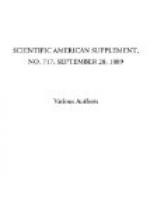To test accuracy of form, the weight of model is carefully taken, and the displacement at the intended trial draught accurately determined from the plan of lines. The difference between the weight of model and the displacement at the draught intended is then put into the bottom of the model in the form of small bags of shot, and by unique and very delicately constructed instruments for ascertaining the correct draught, the smallest error can at once be detected and allowed for. The models vary in size from about one-tenth to one-thirtieth of the size of the actual ship. A model of the largest size can be produced and its resistance determined at a number of speeds in about two days or so. The mode of procedure in arranging the model for the resistance experiment, after the model is afloat in the tank at the correct draught and trim, consists in attaching to it a skillfully devised dynamometric apparatus secured to a lightly constructed carriage. This carriage traverses a railway which extends the whole length of the tank about 15 in. or 18 in. above the water. The floating model is carefully guided in its passage through the water by a delicate device, keeping it from deviating either to the right or left, but at the same time allowing a free vertical and horizontal motion. The carriage with the model attached is propelled by means of an endless steel wire rope, passing at each end of the tank around a drum, driven by a small stationary engine, fitted with a very sensitive governor, capable of being so adjusted that any required speed may be given to the carriage and model. The resistance which the model encounters in its passage through the water is communicated to a spiral spring, and the extension this spring undergoes is a measure of the model’s resistance. The amount of the extension is recorded on a revolving cylinder to a much enlarged scale through the medium of levers or bell cranks supported by steel knife edges resting on rocking pieces. On the same cylinder are registered “time” and “distance” diagrams, by means of which a correct measure of the speed is obtained. The time diagram is recorded by means of a clock attached to an electric circuit, making contact every half second, and actuating a pen which




